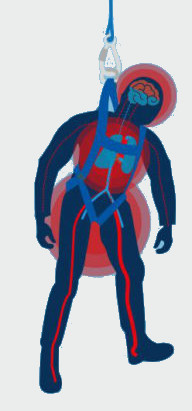Suspension trauma
Falling from a height brings with it many dangers and consequences as a result of the incident that occurred. Increase in awareness of safety during work at a height is resulting in popularization of fall protection systems and also personal protection equipment. Person who correctly uses said system is secure as long as the safety harness in on and its connected to fall protection system in accordance with the norms. In case of tripping and falling from the roof the systems stops the user and hitting the ground doesn’t take place. However in this moment person is hanging, has no possibility to return up and to get down. This person must wait for someone comes to the rescue. It seems they can be hanging there for hours before this happens. Yet very few people seem to realize that on this stage we face another danger – the so called hanging shock.
When a person hangs on safety harness their legs don’t have any support, harness bites into femoral artery. It is an unnatural state for our organism and therefore we are not adapted to it as our natural position is a standing one. Blood cannot freely circulate and reach lower limbs, so our muscles start to cramp and legs go numb.
Symptoms of suspension shock appear rather quickly, as fast as few minutes in our legs go numb, while after 15-20 minutes more symptoms get more severe – dizziness, blurred vision, increased sweating and shortness of breath. Afterwards person loses consciousness and after some time this can lead to death as a result of cerebral hypoxia.
There are of course certain methods to resist such cases described above – such as proper equipment and training. The right kind of safety harness should be equipped with proper leg support – belts on which user can rest their legs during suspension. This way the harness won’t stop the blood from flowing and the person can simulate standing up. Blood circulation is uninterrupted. Belts should be placed on the sides of the harness on specially intended handles. Most commonly they are placed around the waist. They are rolled up and after the user falls down, he can unroll them, bind them together and after regulating the right length he can stand on them to bring back blood flow. In this position he can await the rescue. This demonstrates how important proper training and right harness is for a work at a height. Many people that use safety harnesses don’t realize such belts exist and they are not aware of consequences brought by being suspended without proper support.
When worker is brought back on the ground and is unconscious, he requires first aid immediately. In the beginning we place him in the lateral recovery position according to first aid basics. If this person stops breathing and their heart stops we must begin resuscitation. First we call for an ambulance of course and then traditional cardiopulmonary resuscitation. If everything else fails the next step is to use defibrillator if there is one nearby. After all this only special medical service can help.
When worker didn’t lose consciousness or he regained it on his own but he was suspended for over 20 minutes, medical help is still necessary. After returning to the ground person should rest in a sitting position (shouldn’t be standing or laying down) and await medical help.
To summarize, it is not enough to use safety harness and be connected to fall protection system. There is knowledge and training required and also proper equipment provided with rescue belts. To minimize all the risks every employee not only the ones doing the job should be properly trained.

